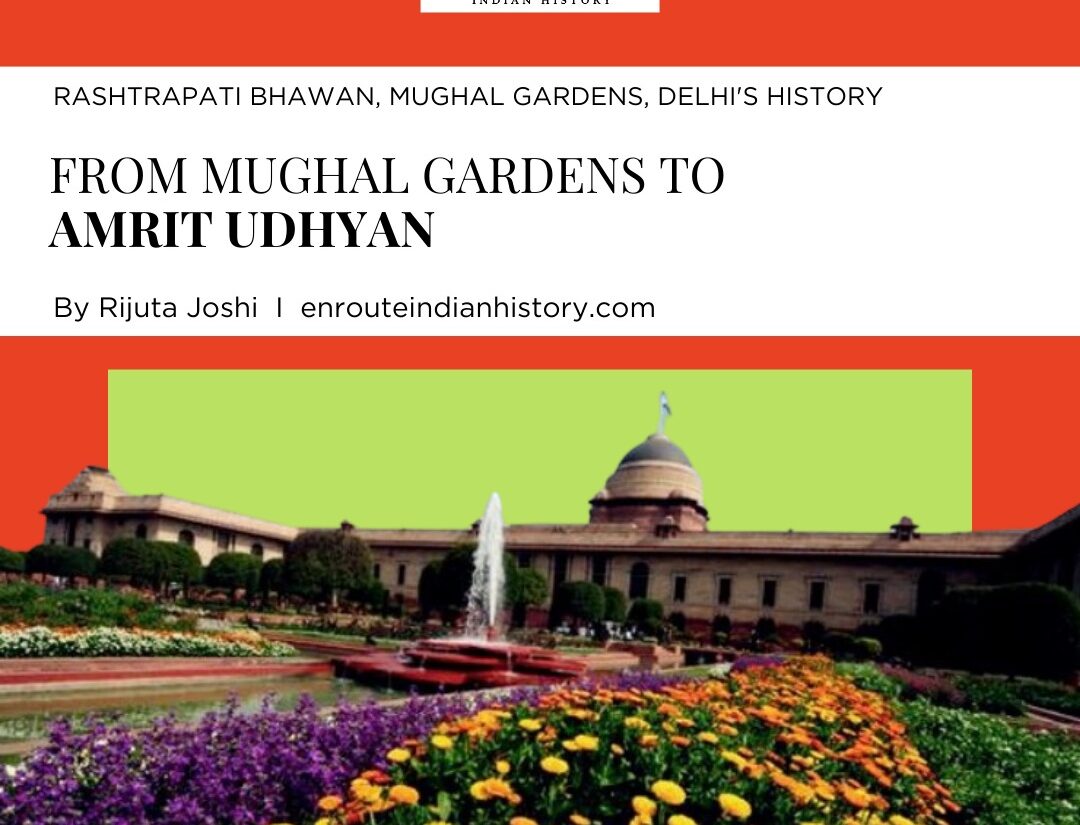
The famous Mughal Garden in the Rashtrapati Bhavan complex in New Delhi has been renamed Amrit Udyan, reflecting greater changes in India’s political and cultural landscape as well as a momentous occasion in the garden’s history. The Mughal gardens served as an inspiration for the garden, which was first created by British architect Edwin Lutyens during the colonial era and represented imperial supremacy. Its moniker, “Mughal Garden,” alluded to the opulence of Mughal architecture as well as India’s rich history.
However, there has been a trend of renaming locations and landmarks connected to colonial or imperial legacy since India’s independence and subsequent attempts to restore its cultural identity. The change in name of the development of the Mughal Garden in this particular context. It explores the paradox of how a garden created by a British architect during the colonial era—despite its imperial beginnings—came to be called the “Mughal Garden.” The essay presents a case study of Amrit Udyan to illustrate the challenges associated with cultural identity, historical preservation, and India’s ongoing decolonization process.
HISTORY OF GARDENS
Gardens have held a significant place in human history, serving as spaces of beauty, tranquility, and cultivation. Essentially, gardens are cultivated patches of land where various plants, flowers, and sometimes even trees are grown for aesthetic, recreational, or functional purposes. Gardens are distinguished from the main part of property either by boundary demarcations or by changed in architectural style. It is difficult to classify the types of gardens because of the variation in understanding of what exactly is a garden. Campbell in his book ‘A Short History of Gardens’ mentions the different notions of what constitute a garden in the western and eastern cultures. While in West, it is majorly surrounded around flora and biblical references, in East it centres around stones, medicinal herbs and domesticated tress. They can range from small, intimate spaces to vast landscapes, and they often reflect the cultural and artistic sensibilities of their creators. Gardens can serve as places for relaxation, meditation, social gatherings, or even food production.

Islamic gardens, in particular, have a distinct character influenced by Islamic principles and aesthetics. These gardens typically feature geometric layouts, water elements such as fountains or pools, and lush vegetation. They are designed to provide shade, privacy, and a sense of serenity, often incorporating elements of symmetry and balance. Islamic gardens are intended to evoke paradise, as described in Islamic texts, with flowing water symbolizing purity and abundance, and lush greenery representing fertility and abundance.
Throughout history, gardens have played a significant role in various cultures and civilizations. In ancient times, gardens were associated with royalty and the elite, serving as symbols of power and wealth. The Hanging Gardens of Babylon, one of the Seven Wonders of the Ancient World, is a notable example of an early garden known for its elaborate design and lush vegetation. In medieval Europe, gardens were often cultivated within the confines of monasteries and castles, serving both practical and spiritual purposes. David Cooper in his book ‘The Philosophy of Gardens’ explores the sociological and spiritual aspect of keeping a garden and how it has been a metaphor for imposition of order. He explores the idea through classical literature by Shakespeare and Voltaire.
Over time, the concept of gardens evolved, with different cultures and regions developing their own unique styles and techniques. From the formal gardens of Versailles to the Zen gardens of Japan, gardens continue to be appreciated for their beauty, symbolism, and connection to nature. Today, gardens remain popular as both private retreats and public spaces, providing people with opportunities to escape the hustle and bustle of daily life and reconnect with the natural world.
HISTORIC GARDENS AND THEIR RESTORING

Historic gardens are considered “living monuments” with significant cultural value, according to the Florence Charter. They are classified as cultural heritage by organizations like ICOMOS and IFLA, requiring specific protection measures and scientific studies. UNESCO also recognizes their tangible and intangible values, emphasizing the importance of preserving cultural diversity over time and space. The European Landscape Convention underscores the need for protection and management of all landscapes, including historic gardens. However, restoring historic gardens is complex due to various factors such as lack of knowledge, low management investments, climate change adaptation, and invasive species control.
Many historic gardens face issues like abandonment, leading to loss of their original structure and identity. Governance of these gardens presents a challenge, with various studies focusing on restoration efforts. For example, botanical investigations were conducted in Sarajevo’s Great Park to identify species and evaluate forestry measures. In Liguria, Italy, a research project aimed to address palm diseases affecting the landscape by valorizing public gardens designed by Ludwig Winter. Similar historic approaches were used for restoring Barnsley Gardens in Georgia and gardens in Tabriz, Iran.
However, there is still a lack of a holistic approach in the scientific literature for evaluating historical, compositional, and botanical features of historic gardens in relation to current needs and issues. These gardens are essential components of urban green infrastructure, providing ecosystem services that enhance citizens’ well-being. Adopting new holistic approaches for restoration and management of historic gardens is crucial for the community.
CASE OF AMRIT UDYAN

The evolution of Mughal gardens to Amrit Udyan represents a fascinating journey through history, architecture, politics, and cultural relevance. Mughal gardens, known for their exquisite beauty and meticulous design, have left an indelible mark on India’s landscape. Amrit Udyan, formerly known as the Mughal Gardens located within the premises of Rashtrapati Bhavan in Delhi, holds a special place in India’s heritage and continues to be a symbol of elegance and grandeur.
Historically, Mughal gardens trace their origins back to the Mughal Empire, particularly during the reign of Emperor Babur in the 16th century. Influenced by Persian and Islamic garden traditions, Mughal gardens were characterized by symmetrical layouts, flowing water features, lush greenery, and fragrant flowers. These gardens served multiple purposes, including providing a retreat for the royal family, showcasing the empire’s wealth and power, and serving as symbols of paradise on Earth.
Over time, Mughal gardens evolved in style and design, incorporating elements from various cultures and regions of India. The gardens at Rashtrapati Bhavan, designed by British architect Sir Edwin Lutyens during the construction of the presidential residence in the early 20th century, were influenced by Mughal and British garden traditions. Lutyens blended Mughal-inspired features with English landscaping principles to create a unique fusion of styles.
The architectural values of Amrit Udyan lie in its meticulous planning, harmonious design, and attention to detail. The garden’s layout reflects Lutyens’ vision of grandeur and elegance, with terraced lawns, geometric flower beds, meandering pathways, and strategically placed water bodies. The garden’s architectural elements, such as the imposing Jaipur Column and the ceremonial amphitheater, add to its aesthetic appeal and historical significance. This is also symbolic of unity in diversity of the country.
Amrit Udyan holds immense cultural and historical relevance as one of India’s most iconic gardens. It serves as a testament to the rich cultural heritage of India, blending Mughal, British, and indigenous influences into a harmonious whole. The garden’s lush greenery, vibrant blooms, and serene ambiance make it a popular destination for tourists and locals alike, offering a glimpse into India’s regal past and architectural prowess.

The purpose of Amrit Udyan extends beyond its aesthetic appeal to encompass various functions and activities. Apart from serving as a recreational space for the President and visiting dignitaries, the garden hosts cultural events, public gatherings, and educational programs. It also plays a vital role in promoting environmental awareness and biodiversity conservation, showcasing a diverse range of plant species and ecosystems.
However, the political air surrounding the renaming of Mughal Gardens to Amrit Udyan reflects broader debates about identity, nationalism, and historical symbolism in India. The decision to rename the garden was met with mixed reactions, with some viewing it as a positive step towards reclaiming India’s indigenous heritage, while others saw it as a political move aimed at rewriting history and erasing Mughal influences.
The Mughal Gardens’ rebranding as Amrit Udyan is a dramatic change that encompasses a number of aspects, such as politics, architecture, history, and cultural importance. This progression is a reflection of India’s effort to acknowledge its colonial past while also asserting its indigenous roots and rewriting the story of its cultural heritage. The change in name from Mughal Gardens to Amrit Udyan signifies a break from colonial roots. From a political perspective, the garden’s new name mirrors larger discussions in India about nationalism and identity. The choice to call the Mughal Gardens Amrit Udyan is indicative of a movement to restore India’s cultural identity and fits into a broader trend of renaming sites connected to colonial or imperial heritage. But it also calls into question the elimination of some historical narratives and the political manipulation of history.
Thus the transition from Mughal Garden to Amrit Udyan is more than just a name change, it reflects a complicated interplay of politics, design, history, and cultural significance. Amrit Udyan’s continued prosperity is evidence of India’s resilient cultural identity and capacity to change while upholding its history. This famous garden, also known as Amrit Udyan or Mughal Gardens, continues to be a source of pride for the country and a representation of its rich cultural heritage.
REFERENCES
- Campbell, G., 2016. A short history of gardens. Oxford University Press.
- https://thewire.in/government/mughal-gardens-amrit-udyan-rashtrapati-bhavan-website
- https://timesofindia.indiatimes.com/city/delhi/delhi-rashtrapati-bhawan-mughal-gardens-renamed-amrit-udyan-sir-edwin-lutyen-english
- https://www.hindustantimes.com/cities/delhi-news/rashtrapati-bhavan-gardens-to-now-be-called-amrit-udyan-101674929833188.
- html-flower-garden/photostory/97412104.cms
- https://www.thehindu.com/news/national/explained-the-story-behind-rashtrapati-bhawans-mughal-gardens-now-the-amrit-udyan/article66450935.ece
- https://indianexpress.com/article/explained/rashtrapati-bhavans-mughal-gardens-renamed-a-brief-history-8409859/
- https://indianexpress.com/article/explained/rashtrapati-bhavans-mughal-gardens-renamed-a-brief-history-8409859/
- https://www.outlookindia.com/national/mughal-garden-renamed-ro-amrit-udyan-in-delhi-s-rashtrapati-bhavan-news-257518
- https://ddnews.gov.in/national/amrit-udyan-formerly-known-mughal-garden-reopens-general-public
- https://www.hindustantimes.com/cities/delhi-news/rashtrapati-bhavan-gardens-to-now-be-called-amrit-udyan-101674929833188.
- May 15, 2024
- 6 Min Read























